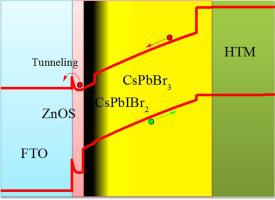当前位置:
X-MOL 学术
›
Sol. Energy
›
论文详情
Our official English website, www.x-mol.net, welcomes your
feedback! (Note: you will need to create a separate account there.)
Optimizing the working mechanism of the CsPbBr3-based inorganic perovskite solar cells for enhanced efficiency
Solar Energy ( IF 6.0 ) Pub Date : 2020-10-01 , DOI: 10.1016/j.solener.2020.09.003 Saad Ullah , Ping Liu , Jiaming Wang , Peixin Yang , Linlin Liu , Shi-E. Yang , Haizhong Guo , Tianyu Xia , Yongsheng Chen
Solar Energy ( IF 6.0 ) Pub Date : 2020-10-01 , DOI: 10.1016/j.solener.2020.09.003 Saad Ullah , Ping Liu , Jiaming Wang , Peixin Yang , Linlin Liu , Shi-E. Yang , Haizhong Guo , Tianyu Xia , Yongsheng Chen

|
Abstract Recently, inorganic perovskite solar cells (PSCs) based on CsPbBr3 have triggered incredible interest due to the demonstrated excellent stability against thermal and high humidity environmental conditions. However, the power conversion efficiency (PCE) of the CsPbBr3-based PSCs is still lower than that of the organic-inorganic hybrid one, because of the large band gap and serious charge recombination at the interface or inside the device. Here, the working mechanism of the devices with normal n-i-p planar structure is modeled and investigated using SCAPS 1D simulation software. The simulation results state that the proper band structure of PSCs is crucial to carrier separation and transport. The high interface recombination, originated from the large band offsets of the electron transport material (ETM)/absorber and absorber/hole transport material (HTM) respectively, can be effectively diminished with the continuous gradient junction design of the absorber, and a PCE of 11.58% is obtained with a high open-circuit voltage (VOC) of 1.68 V. Moreover, by building a heterojunction bilayer absorption scenario of CsPbIBr2/CsPbBr3 and employing ZnOS and Cu2ZnSnS4 films as the ETM and HTM respectively, the PCE of PSCs is further increased to 15.89%, caused mainly by the enhancement in short-current density (JSC). Moreover, reducing the interface defect density is also very important to improve the performance of PSCs. These results will provide theoretical guidance for improving the performance of the CsPbBr3-based PSCs.
中文翻译:

优化CsPbBr3基无机钙钛矿太阳能电池的工作机制以提高效率
摘要 最近,基于 CsPbBr3 的无机钙钛矿太阳能电池 (PSC) 因其在热和高湿度环境条件下表现出的出色稳定性而引起了极大的兴趣。然而,CsPbBr3 基 PSCs 的功率转换效率 (PCE) 仍然低于有机-无机杂化 PSCs,因为带隙大,界面或器件内部的电荷复合严重。在这里,使用 SCAPS 1D 仿真软件对具有正常 nip 平面结构的设备的工作机制进行建模和研究。模拟结果表明,PSC 的适当能带结构对载流子分离和传输至关重要。高界面复合,源自电子传输材料(ETM)/吸收体和吸收体/空穴传输材料(HTM)的大带偏移,可以通过吸收体的连续梯度结设计有效地减少,并且获得11.58%的PCE 1.68 V 的高开路电压 (VOC)。此外,通过构建 CsPbIBr2/CsPbBr3 的异质结双层吸收方案,并分别采用 ZnOS 和 Cu2ZnSnS4 薄膜作为 ETM 和 HTM,PSC 的 PCE 进一步提高到 15.89%,主要是由于短路电流密度(JSC)的提高。此外,降低界面缺陷密度对于提高 PSC 的性能也非常重要。这些结果将为提高基于 CsPbBr3 的 PSC 的性能提供理论指导。可以通过吸收体的连续梯度结设计有效减少,在 1.68 V 的高开路电压 (VOC) 下获得 11.58% 的 PCE。 此外,通过构建 CsPbIBr2/CsPbBr3 的异质结双层吸收场景和分别使用 ZnOS 和 Cu2ZnSnS4 薄膜作为 ETM 和 HTM,PSC 的 PCE 进一步提高到 15.89%,这主要是由于短路电流密度(JSC)的提高。此外,降低界面缺陷密度对于提高 PSC 的性能也非常重要。这些结果将为提高基于 CsPbBr3 的 PSC 的性能提供理论指导。可以通过吸收体的连续梯度结设计有效减少,在 1.68 V 的高开路电压 (VOC) 下获得 11.58% 的 PCE。 此外,通过构建 CsPbIBr2/CsPbBr3 的异质结双层吸收场景和分别使用 ZnOS 和 Cu2ZnSnS4 薄膜作为 ETM 和 HTM,PSC 的 PCE 进一步提高到 15.89%,这主要是由于短路电流密度(JSC)的提高。此外,降低界面缺陷密度对于提高 PSC 的性能也非常重要。这些结果将为提高基于 CsPbBr3 的 PSC 的性能提供理论指导。通过构建 CsPbIBr2/CsPbBr3 的异质结双层吸收方案,并分别使用 ZnOS 和 Cu2ZnSnS4 薄膜作为 ETM 和 HTM,PSC 的 PCE 进一步提高到 15.89%,这主要是由于短电流密度(JSC)的增强。此外,降低界面缺陷密度对于提高 PSC 的性能也非常重要。这些结果将为提高基于 CsPbBr3 的 PSC 的性能提供理论指导。通过构建 CsPbIBr2/CsPbBr3 的异质结双层吸收方案,并分别使用 ZnOS 和 Cu2ZnSnS4 薄膜作为 ETM 和 HTM,PSC 的 PCE 进一步提高到 15.89%,这主要是由于短电流密度(JSC)的增强。此外,降低界面缺陷密度对于提高 PSC 的性能也非常重要。这些结果将为提高基于 CsPbBr3 的 PSC 的性能提供理论指导。
更新日期:2020-10-01
中文翻译:

优化CsPbBr3基无机钙钛矿太阳能电池的工作机制以提高效率
摘要 最近,基于 CsPbBr3 的无机钙钛矿太阳能电池 (PSC) 因其在热和高湿度环境条件下表现出的出色稳定性而引起了极大的兴趣。然而,CsPbBr3 基 PSCs 的功率转换效率 (PCE) 仍然低于有机-无机杂化 PSCs,因为带隙大,界面或器件内部的电荷复合严重。在这里,使用 SCAPS 1D 仿真软件对具有正常 nip 平面结构的设备的工作机制进行建模和研究。模拟结果表明,PSC 的适当能带结构对载流子分离和传输至关重要。高界面复合,源自电子传输材料(ETM)/吸收体和吸收体/空穴传输材料(HTM)的大带偏移,可以通过吸收体的连续梯度结设计有效地减少,并且获得11.58%的PCE 1.68 V 的高开路电压 (VOC)。此外,通过构建 CsPbIBr2/CsPbBr3 的异质结双层吸收方案,并分别采用 ZnOS 和 Cu2ZnSnS4 薄膜作为 ETM 和 HTM,PSC 的 PCE 进一步提高到 15.89%,主要是由于短路电流密度(JSC)的提高。此外,降低界面缺陷密度对于提高 PSC 的性能也非常重要。这些结果将为提高基于 CsPbBr3 的 PSC 的性能提供理论指导。可以通过吸收体的连续梯度结设计有效减少,在 1.68 V 的高开路电压 (VOC) 下获得 11.58% 的 PCE。 此外,通过构建 CsPbIBr2/CsPbBr3 的异质结双层吸收场景和分别使用 ZnOS 和 Cu2ZnSnS4 薄膜作为 ETM 和 HTM,PSC 的 PCE 进一步提高到 15.89%,这主要是由于短路电流密度(JSC)的提高。此外,降低界面缺陷密度对于提高 PSC 的性能也非常重要。这些结果将为提高基于 CsPbBr3 的 PSC 的性能提供理论指导。可以通过吸收体的连续梯度结设计有效减少,在 1.68 V 的高开路电压 (VOC) 下获得 11.58% 的 PCE。 此外,通过构建 CsPbIBr2/CsPbBr3 的异质结双层吸收场景和分别使用 ZnOS 和 Cu2ZnSnS4 薄膜作为 ETM 和 HTM,PSC 的 PCE 进一步提高到 15.89%,这主要是由于短路电流密度(JSC)的提高。此外,降低界面缺陷密度对于提高 PSC 的性能也非常重要。这些结果将为提高基于 CsPbBr3 的 PSC 的性能提供理论指导。通过构建 CsPbIBr2/CsPbBr3 的异质结双层吸收方案,并分别使用 ZnOS 和 Cu2ZnSnS4 薄膜作为 ETM 和 HTM,PSC 的 PCE 进一步提高到 15.89%,这主要是由于短电流密度(JSC)的增强。此外,降低界面缺陷密度对于提高 PSC 的性能也非常重要。这些结果将为提高基于 CsPbBr3 的 PSC 的性能提供理论指导。通过构建 CsPbIBr2/CsPbBr3 的异质结双层吸收方案,并分别使用 ZnOS 和 Cu2ZnSnS4 薄膜作为 ETM 和 HTM,PSC 的 PCE 进一步提高到 15.89%,这主要是由于短电流密度(JSC)的增强。此外,降低界面缺陷密度对于提高 PSC 的性能也非常重要。这些结果将为提高基于 CsPbBr3 的 PSC 的性能提供理论指导。









































 京公网安备 11010802027423号
京公网安备 11010802027423号